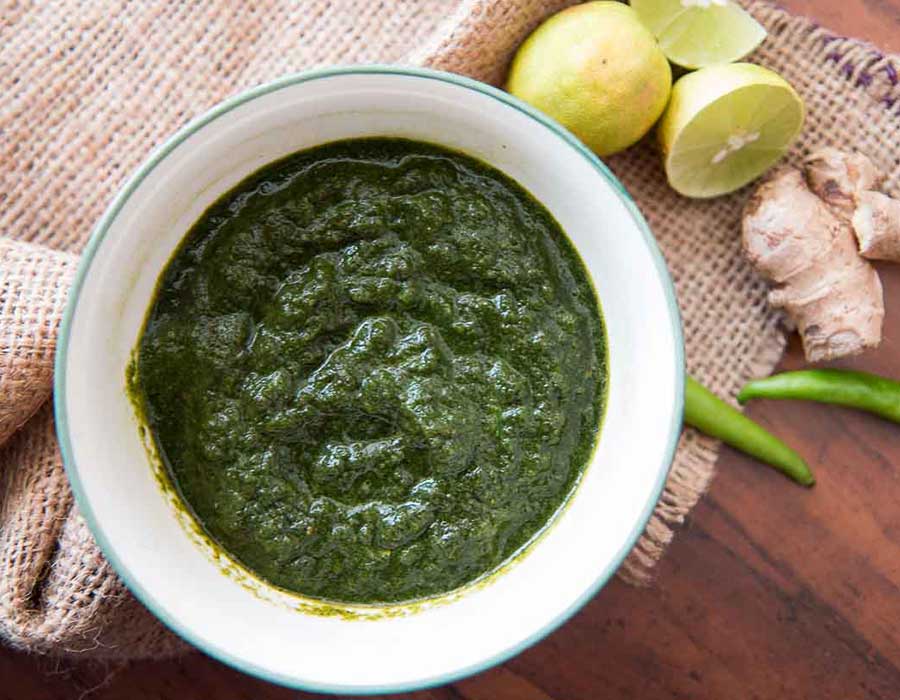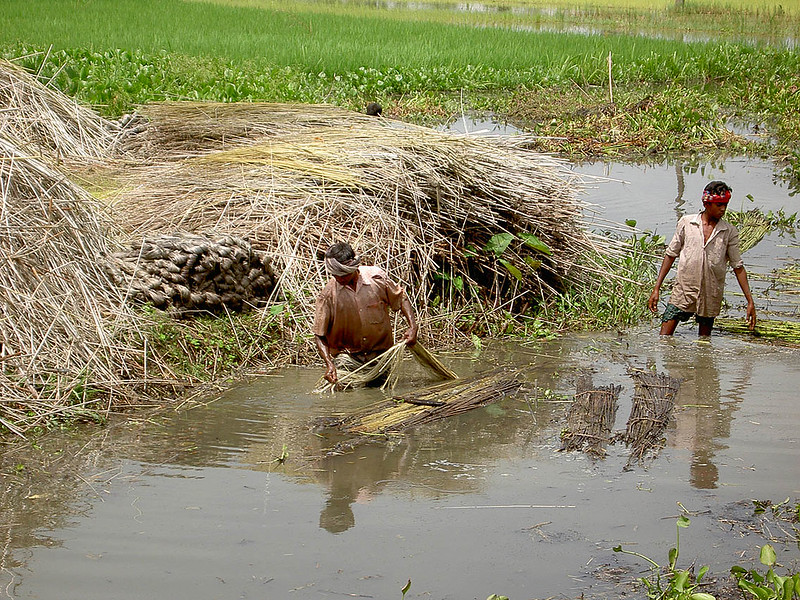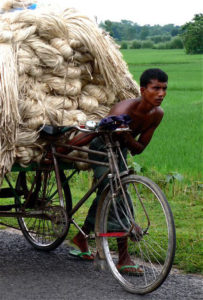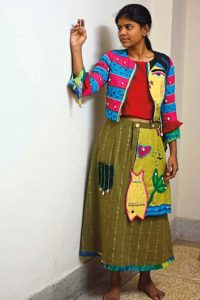From her high-rise flat in Kamalapur in downtown Dhaka, Nishat Tuly reviews a few of her recent clothing designs. Outside her window, within walking distance from Bangladesh’s largest train station, a determined monsoon rain comes down in a roar. At 26, the median age in this Southeast Asian nation of 165 million, she is an up-and-coming fashion designer in pursuit of the next trend. That, she says, points her toward environment-friendly materials as the go-to fabrics of the future—and specifically, jute.
“The market of jute and jute-related products is increasing day by day,” Tuly says, explaining that what was once Bangladesh’s most important agricultural crop is making a serious comeback.
Her most-recent creation, inspired by Bangladeshi painter Qayyum Chowdhury, embraces jute as sustainable fashion.
“The environmental issues are gaining in popularity,” she says.
A hectare of jute gobbles around 13.6 tonnes of carbon dioxide and returns to the atmosphere 10 tonnes of oxygen.
A historical plant with many uses
Historically, jute has been a staple of both fabric and food for more than 2,000 years. The earliest mention of what appears to be jute is found in a description written by Pliny the Elder in the first century ce. In his book The Natural History, the Roman author and philosopher refers to the plant by its genus name, Corchorus, describing its benefits and how people in Alexandria consumed its jute mallow leaves.
“The leaves of it are rolled up, one upon the other … for the viscera, and in cases of alopecy, being good also for the removal of freckles,” he wrote.

Today, Egyptians mince jute leaves and fry them alongside garlic and lamb in a popular dish called molokhiya, often served with chicken and rice. And Egyptians are not alone at the table: Cypriots simmer jute leaves into a tomato stew, while chefs in Thailand blanche them like spinach in a recipe known as bai po. In Sierra Leone jute is stewed with fufu, a cassava-based porridge, and it is from that West African country that jute is said to have made its voyage to the New World with the human trafficking of the slave trade—especially to the Caribbean island of Haiti, where it features in lalo, a dish of blue crabs, jute leaves and lemon juice.
Jute fiber has no less of a long history as a material for rope and coarse-thread items such as large transport bags and heavy-duty baskets. In this manner the product was sailed across the Pacific to furnish island markets. In India, in 1590, the Mughal Emperor Akbar, who ruled over most of the Indian subcontinent, noted in the Ain-i-Akbari that in the province of Ghoraghat, today in northern Bangladesh, “silk is produced and a kind of sackcloth” was worn. Europeans wove jute into what came to be called hessian, burlap or gunny, which is still widely used for sacks, mats and nets. During World War i, an estimated 1 billion or more hessian sandbags lined the trenches of Belgium and France.
Jute’s widespread presence in India and Bangladesh
Botanically speaking, Corchorus capsularis or white jute produces the finest fibers, but Corchorus olitorius or tossa jute grows in greater abundance. Both species are the leading sources of both edible jute and jute fiber, and both grow as woody, emerald spears topped by a frilly crown of 10-centimeter-long leaves. Jute has colonized soils in hot, humid, mostly wetland climates the world over, from Brazil to Vietnam, from El Salvador to every equatorial African state. Yet no environment is better for growing jute than the sultry Ganges Delta of the eastern Indian subcontinent, the largest wetland of its kind in the world.
Encompassing two-thirds of Bangladesh and a section of India, this green triangle ranks among the most fertile—and fragile—places on Earth, fed by two mighty rivers, the Ganges and Brahmaputra. After carrying nutrients for thousands of kilometers, these waterways spill into labyrinthine channels, pools, streams and swamps—each one a watery haven for cultivating jute. Some 150 million people live in this delta the size of Iceland, or the state of Kentucky in the us.

In Bangladesh, jute, or paat in Bangla, supports the livelihoods of 25 million people. Each spring, billions of seeds of Corchorus capsularis and Corchorus olitorius are flung across open ground, mostly by women. The seeds germinate with the first showers, and they grow fast—about 2 centimeters a day. By late spring, the delta pools look like lakes of lime-green saplings, and when the summer’s monsoon rains arrive, the jute stalks shoot up until the heat of August, seldom less than 30 degrees Celsius, given them a final nutrient boost. With no artificial fertilizers or pesticides used, the flowering jute plants will tower some 3 meters.
When it’s time to harvest, laborers wade through standing water to cull the crop by hand with sickles, stripping and separating the leaves from stalks that are bundled and moved to a slow-moving water source. There, the plant’s fibrous innards are extracted in a 10- to 30-day process called pochano, or retting. When the fibers are thoroughly soaked, men armed with hefty wooden mallets wade waist deep into the standing water, grab great bundles of stalks and strip them of their vegetative bark. The stalks are then thoroughly whacked to loosen the fibers that are then pulled from the plant’s woody core. The men then wash, squeeze and dry the retted, stripped fibers in the sun. Once dry, the fibers are baled, and this raw jute is transported to markets and mills almost exclusively by boat—a necessity in a nation with 700 waterways where 50 percent of all cargo journeys are made by river.
As a finished product, jute can be woven, spun and pressed into handbags, hammocks, hats and a hundred or more other items. As a wearable textile, it offers natural ultraviolet protection to the skin; as a household material, it is flame retardant; as rope, its tiny fibrous hairs offer unrivalled grip. Indeed, jute is so ingrained into Bangladeshi culture that its leaves feature on the national emblem, and the government has a Ministry of Textiles and Jute. There’s even a National Jute Day, March 6, to observe jute’s endowment to heritage and its future in the manufacture of items that are all fully biodegradable and largely inexpensive.
Jute’s economic crisis

In the 1950s, however, jute plunged in popularity when polythene became a low-cost alternative for grocery bags and commercial packaging. Together with polystyrene (from the 1960s onward) and polyethylene terephthalate (pet, the compound used to make plastic bottles and product containers), these new plastics replaced almost every jute export. By the 1980s, Bangladeshi farmers were burning jute fields to replace them with other cash crops.
Amir Rangan, director of the jute clothing label Khiyoo Fashion, remembers how the local jute mill where his father worked as a timekeeper funded his rural elementary school.
“Gradually factories laid off workers as they lost orders,” says Rangan, 41. “Our young country did not have the skills to adapt jute fiber into new forms because most people were illiterate.”
Millions became jobless. In 1988 a cataclysmic monsoon that left half the country under water compounded the situation. The Adamjee Jute Mill, the first jute processing plant in Bangladesh and the largest in the world, shut down.
“The farmers could not sell their crop,” continues Rangan. “After selling their properties, they started to migrate to towns to change their fate.”
Between 1970 and 2000, the Bangladeshi capital of Dhaka almost doubled in population every decade, becoming the most densely inhabited city in the world, with 44,000 people per square kilometer. Many other people left entirely: The global Bangladeshi diaspora ranks among the world’s largest. The days of the jute farmer, or paat chashi, seemed over.
The future of jute

As the country expanded its cotton clothing sector, Rangan began to wonder if he could replace cotton, which the country spends more than $5 billion annually to import, with nationally grown jute.
“It would take me a lot of research to invent a successful clothes fabric from jute,” Rangan remembers. In 2007 he organized the country’s first and largest jute-garment exhibition at Dhaka University. While traditionally jute garments were “a little thick” because they were exported to “winter-prone countries,” Rangan later presented jute garments at Western-style fashion shows, and this put his creations in front of national television and newspaper audiences.
“I gained a wide reputation,” he says.
Rangan now shares his production skills with 12 universities across Bangladesh.
“Bangladeshis used to consider jute to be quite primitive, so not fashionable,” he explains. “So, by holding fashion shows of jute garments we can show the many ways the product can be used.”
For the last six years, Rangan has worn what he calls his “jute uniform” every day. At the National Jute Fair in 2020, he showcased his garments alongside other jute items, including soil-erosion screens and sapling nursery bags that biodegrade when vegetation stabilizes. As he explains:
“It’s all about raising awareness. Then these young students can diversify jute into many other products. Nowadays we are very busy destroying our climate balance. To make a better world, the use of green products are the single most important solution.”
By 2050 plastic production and incineration are forecast to contribute as much as 10 to 15 percent of the world’s global-warming gases, according to a 2019 Center for International Environmental Law report. Climate change looms potentially catastrophic for Bangladesh in particular, as the delta lands are all little higher than sea level. Yet here, too, jute pulls more than its weight: According to the Food and Agriculture Organization of the United Nations, a hectare of jute gobbles around 13.6 tonnes of carbon dioxide and returns to the atmosphere 10 tonnes of oxygen. That same hectare of jute also drops about 10 million leaves, and those not harvested compost and fertilize the area for future crops. Jute actually makes land more productive, so much so that a follow-on crop of rice can be sown in the same place immediately after the jute harvest.
By replacing wood, jute can also reduce deforestation. Wood and paper products are the fourth major driver of deforestation after cattle ranching, soybean farming and palm-oil production, contributing to about 10 percent of globally felled trees. Given more investment, jute has the potential to replace a significant proportion of wood-based items, from screening walls to shopping bags. The woody cores of jute sticks, historically seen as a byproduct, can also produce charcoal for carbon paper, firesticks, cosmetics and printer ink. While most trees take more than 10 years to mature to harvest, jute takes months.

The Ministry of Textiles and Jute is driving further diversification. Its motivational schemes include asking schools to supply pupils with backpacks and book sacks made from jute. Bangladesh’s highways department has requested use of GeoJute, an inexpensive biodegradable net that prevents soil erosion. The ministry also founded the Jute Diversification Promotion Centre, which supports entrepreneurs like Rangan in experimenting with new jute products.
Abdul Quayyum, secretary general of the Bangladesh Jute Association, supports such action. His role is to boost trade in a country that already exports two-thirds of the world’s jute.
“We call jute ‘the golden fiber,’” says Quayyum. “The fiber is very strong and has so many uses. And when drying on bamboo poles, it takes the color of gold.”
Quayyum, who graduated from college in 1967 and is environmentally passionate, encourages younger generations.
“Synthetic polythene bags are the cancer in society,” he asserts, referring to the volume of unrecycled plastic packaging.
“In the bottom of the rivers, synthetic bags are stacked there. They will never rot and are hampering the depth of the river and poisoning the fish.”
Quayyum is promoting a globalized solution. Automobile giants like Ford and Toyota already use 100,000 tonnes of jute each year to create heavy-duty carpets and seats. “Now in Germany they are now using jute to create glass fiber and to create doors for cars,” explains Quayyum. “In South Korea they are making the same.”
Yet just 10 percent of the jute used in the automobile industry comes from Bangladesh, and there’s a sense that if the country is going to change the world with its miracle plant, innovation and investment are going to be the name of the future game.
There is abundant evidence that Bangladesh is eager to address the challenge. To travel through the rural hinterlands is to witness the diversity and evolution of jute, as if its fibers actually tie the nation together. At riverside restaurants, diners sit on jute cushions. They are served their ilish macher paturi, a marinated fish steamed in banana leaves, and chotpoti, a chickpea rice with chillies, eggs and cilantro, on jute tablecloths. At home, jute is in the carpets, cupboards, trashcans and toys. Jute matting creates temporary clinics and storage rooms. When jute carpets become ripped, or a birthday gift is needed, a new one can be pressed or woven—and the old one swiftly and cleanly composted. At times the entire country appears biodegradable.
“It could replace 90 percent of packaging materials and almost all grocery sacks”, Mohammad Sabuj Hossain.
Source: AramcoWorld (click here to read the full article)
Author: Tristan Rutherford
This post is available in: English

